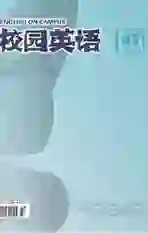Contrast Study of Two Translations of Tian Jing Sha Qiu Si
2019-11-28XingtongChen
Xingtong Chen
The world-renowned Chinese poems constitute a splendid part of Chinese traditional culture, one of which named Tian Jing Sha Qiu Si poetized by Zhiyuan Ma, an ancient dramatist from Yuan Dynasty, is particularly famous all over the world, attracting lots of experts to translate it into other languages. This paper compares and studies two English translation versions of the poem. The source and translations are as follow.
天凈沙·秋思
(元) 马致远
枯藤老树昏鸦, 小桥流水人家, 古道西风瘦马。
夕阳西下,断肠人在天涯。
Autumn
----Translated by Xian-liang Weng
Crows hovering over rugged old trees wreathed with rotten vine--- the day is about done. Yonder is a tiny bridge over a sparkling stream, and on the far bank, a pretty little village. But the traveler has to go on down this ancient road, the west wind moaning, his bony horse groaning, trudging towards the sinking sun, farther and farther away from home.
Tune to “Sand and Sky” ----Autumn Thoughts
----Translated by Wayne Schlepp
Dry vine, old tree, crows at dusk,
Low bridge, stream running, cottages,
Ancient road, west wind, lean nag.
The sun westering
And one with breaking heart at the skys edge.
The first translation is provided by Xianliang Weng, a respected Chinese translator specializing in ancient poetry translation; while the latter one is translated by an American scholar called Wayne Schlepp. Generally speaking, they adopt different translation tactics. Wengs work is reader-oriented by preferring free translation and dynamic equivalence, and Schlepp, centers his translation on Zhiyuan Ma, the writer, thus selecting literal translation which focuses on formal equivalence. From the perspective of linguistics, English is a hypotactic language featured by close-knit sentence structure, but Chinese is parataxis-prominent with relatively free sentence structure, which is reflected more prominently in Chinese poems, expressing multifaceted significance within small and simple phrases.
The first three sentences in the source text include nine images, namely vine, tree, crown, bridge, water, village, road, wind and horse, each with implied meanings. For instance, in Chinese culture, horse is a image with a hint of being away from home and the travelers nostalgia, and the old tree and dry vine suggest the ruthless time elapse. Moreover, these images are not coincidentally or randomly placed together, but intentionally divided into three groups and designed to connect to others, forming three different scenes respectively. Together, they set a tone of stern, solitude and dreariness, resulting in a resonance between reader and writer, so whether the translation can achieve the same effect is crucial. When translating, Schlepp frequently uses adjective-noun phrases in order to maintain the structure, but neglects the maintanence of semantics inevitably. Cultural meaning and structural meaning are lost in her version to some extent, which might confuse the readers consequently. As for Wengs version, its more reader-friendly with the usage of translation techniques like amplification and inversion. He adds “ hovering over” and “wreathed with” to concatenate vine, tree and crown, turning inanimate images into vivid scene. Additionally, he supplements “the day is about done” in the end to further disclose the implications.
The next three images, bridge, stream and village, are relatively independent form the first group, forming another scene with a slightly different atmosphere, but they still relate to the first sentence on the context level. Schlepp leaves the comprehension part to readers themselves by copying the layout of the original text without any conjunction. However, Weng sticks to his strategy, appending “Yonder” to transfer audiences to another scenery, trying to make his expression more coercive and coherent. He also adds warmth to his words and expressions by using “sparkling” to modify “stream”. As for “古道西風瘦马” and the last part, there also exist conspicuous discrepancies between two versions. Schelepp still rigorously follows the writers pattern, and gives the literal meaning, sky edge, to explain the most important concept “Tianya”. “Tianya”, a word appeared in ancient Chinese poems with extremely high frequency, literally refers to a long distance, but more significantly implies emotions like the sorrow of separation or the soupiness of missing. So the diction “sky edge” is a huge loss on semantic level. Weng here, innovatively combines these two parts into one sentence, considering they are set for the same function, portraying the same scene.
Considering rhythmic aesthetics and musicality, most poets will pay special attention to rhymes, which should also be an essential part in poem translation. As a experienced expert on poem translation, Weng suggests that rhymes should not be imposed on and are not supposed to rigidly adhere to the original text. A good case in point is that Weng adds two verbs “moaning” and “groaning” in order to rhyme with “road”. Schlepp is also a knowledgeable man who has unique understanding of Yuan Qu, a type of verse or poem handed down from Yuan Dynasty. She focuses her research on some distinct rhymes of Yuan Qu including feminine rhyme, internal rhyme and polysyllable rhyme. Anyway, her learning doesnt reflect on her translation in terms of rhymes. In regard to their diction, two translators manifest different strategies. Schlepp is more faithful to the original text, while Weng appears to be more creative. For instance, “枯”means that something, usually referring to plants, wither due to hydropenia. Schlepp only chooses a simple word, dry, but Weng seems to overtranslate it into “rotten”. One controversial point of Schlepps version is that, she doesnt translate every phrase in unified pattern. Its clear that she mainly adopts modifier-core structure such as “Dry vine” and “Low bridge”, except “stream running” and “sun westering” emerging in subject-predicate structure, which seems to be incompatible to the text.
To summarize, Weng and Schlepp provide entirely different translations for later generations to research into, and they both have made great contributions to poem translation. In consideration of the overall planning and detail processing, Wengs version is better by one tally.
References:
[1]叶子南.高级英汉翻译理论与实践.[M].北京:清华大学出版社, 2008.
[2]翁显良.情信与词达——谈汉诗英译的若干问题.[J].上海外国语学院报,1980.
【作者简介】Xingtong Chen,Department of Translation and Interpreting Studies, College of Foreign Languages and Literature, Wuhan University.
